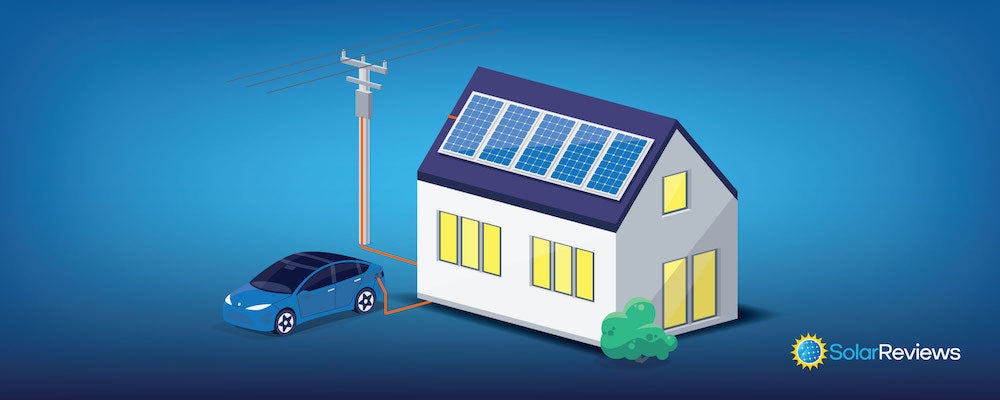
Grid-tied systems are solar power setups that are connected to the electricity grid — and work without any battery backup equipment.
They are currently the most common type of solar panel system in American homes. And despite growing interest in battery technologies, most homeowners going solar today still opt for installing a grid-tied set up on their roofs.
So how do grid-tied solar systems work, and why are they so popular? More importantly, are they the right kind of system for you? This blog will take an in-depth look at this system type and help you answer those questions.
A quick note: this type of solar panel system is known by many names, such as ‘on-grid,’ ‘grid-connect(ed),’ ‘grid-intertied’ and ‘grid-direct.’ They all refer to the same thing.
Key takeaways
- The grid-tied solar panel system is the most common solar power setup in American homes.
- Grid-tied systems are ideal for homeowners with access to net metering.
- Pros: Grid-tied setups have low upfront costs and offer high bill savings.
- Cons: Can’t be used for backup power when the grid is down.
What is a grid-tied solar system?
A grid-tied system uses solar panels to generate electricity from sunlight.
Excess power is exported to the utility grid when the household requires more power, those needs are met by imports from the grid.
The solar panels are installed at a location with suitable sun exposure – typically on the roof, but other sites like your backyard can also work – and require wiring to transport electricity between the solar equipment, the home, and the power grid.
Here’s how grid-tied systems are different from other solar panel setups:
- They use grid-tie inverters: Grid-tied solar systems require an inverter that can communicate with the grid; these are known as grid-tie inverters. The grid-tie inverter can intelligently manage the solar panels so that their power is first sent to supply your home before exporting the excess to the grid.
- No batteries needed: They don’t include any form of energy storage to store solar power. This makes grid-tied solar systems both cheaper and simpler to install.
How much does a grid-tied solar system cost?
The average cost of a typical grid-tied solar system is between $12,600 and $14,000 net of the federal solar tax credit. Most systems cost between $2.75 and $3.35, with a national average price of around $3.00 per watt as of 2023.
However, solar system costs can vary a lot based on many factors, such as system size, the state you live in, the brand of solar panels you choose, and even the pitch of your roof.
In the table below, we take a look at how the average price of grid-tied solar panels varies by system size.
| System size | Average system cost* |
| 4 kW | $9,100 |
| 6 kW | $12,390 |
| 8 kW | $15,960 |
| 10 kW | $19,180 |
| 12 kW | $23,100 |
| 14 kW | $26,936 |
| 16 kW | $29,860 |
*Average cost after deducting the federal solar tax credit incentive as of 2023
To see a live price for a solar panel system customized for your home, I recommend you use our advanced solar calculator. It’ll tell you everything you need to know about installing solar panels in your home. You can start by entering your details below.
How grid-tied systems manage power surpluses and shortfalls
What happens to excess solar power production?
In most households, energy usage during the day is relatively low as members tend to be out of the house. This is also when solar panel production is at its peak, so power generation far exceeds energy use.
With grid-tied systems, this excess power is exported to the utility, which earns electric bill credits for the homeowner.
What happens when the sun goes down?
It also means that the house doesn’t run out of power. When the solar panels aren’t producing enough electricity, the system can import the shortfall from the grid.
Can grid-tied solar systems use net metering?
A grid-tied system’s two-way relationship with the grid offers homeowners a major benefit: they can use it to take advantage of net metering.
Where available, net metering lets homeowners earn bill credits for every watt of excess solar energy they send back to the grid. These payments allow the homeowner to dramatically reduce, or even eliminate, their utility usage charges.
The two-minute video below demonstrates how a grid-tied solar system works for a typical family home.
How grid-tied solar systems work over a year
The direction of energy transfers between the home and the grid isn’t just affected by the time of day — it’s also impacted by the seasons.
Let’s take a look at how this plays out for a typical home throughout the year:
Summer
In summer, when the days are long and sunshine plentiful, homes with on-grid systems export more power than they import. Most utilities allow homeowners to save up these credits for use later in the year.
Spring and Fall
Mild weather means moderate power usage, as homes are less likely to require heating or cooling. At this time of year, grid-tied solar systems also produce reasonable amounts of power, so electricity imports and exports tend to be in balance.
Winter
Winter has the shortest days and weakest sunlight, and thus, the lowest solar output. Power usage is also usually quite high at this time, due to high heating usage. Your system will usually import more power over this period than it exports.
Takeaway: Summer exports offset high winter usage
A home with grid-tied solar panels will generate lots of excess solar power during the summer. The homeowner can then carry these credits over and use them during the winter when their grid imports are higher than solar power exports.
In other words, the high solar generation (and exports) over the summer serve to cancel out the relatively high imports of the winter. In fact, with a properly designed system, a home with grid-tied solar panels can even end up with zero net electricity usage charges for the year.
What equipment do you need for a grid-tied solar system?
Grid-tied systems are the easiest solar systems to install. They require the least amount of equipment, as there is no onsite storage equipment or wiring to deal with.
Here are all the components you need for a grid-tied solar system installation:
- Solar panels: These will generate DC electricity. A typical 6-kilowatt solar power system would require roughly 15 individual panels.
- Racking and mounting: These serve to hold the solar panels in place, as well as allow for ventilation to cool the panels.
- Wiring: This conducts the power from the solar panels to the inverter, and then onwards to the home or net meter.
- Solar grid-tie inverter: The grid-tie inverter converts DC electricity from the panels into alternating current (AC) electricity usable by both the house and the grid. It also assesses energy flows in real-time to determine if solar output should be used in the home or exported. There are three types of solar inverters: string inverters, string inverters paired with power optimizers, and microinverters.
- Net meter: This is a meter that allows and monitors the two-way exchange of power between the home and your utility company. If not already installed in your home, the net meter will be provided by the utility once the grid-tied solar system is ready to be connected to the grid.
Pros of grid-tied solar systems
Here’s a quick rundown of the advantages of grid-tied solar panels when compared to other types of solar panel systems:
- Lowest cost: This system doesn’t require a solar battery (such as the Tesla Powerwall), which is good news as solar batteries are still relatively expensive. And since they use less equipment, there’s less work for installers to perform, meaning lower labor costs.
- High savings thanks to net metering: Grid-tied systems can use net metering to sell all surplus power to the grid at the full retail rate. This makes it easy to slash your monthly energy bills.
- Quickest payback: The combination of being the cheapest type of solar panel system and the ability to sell surplus power to the grid results in a quick return on investment. The payback period for grid-tied systems is between 3 and 9 years in most states.
- More reliable than other PV setups: As it requires the least amount of equipment, a grid-tied solar system has the fewest points of potential failure.
Cons of grid-tied solar systems
There's really only one disadvantage of a grid-connected system:
- No power during grid outages: Grid-tied solar systems lack battery storage — which means that they provide no backup power. For safety reasons, this is the case even when power outages occur during daylight hours. Grid-tied solar systems are designed to switch off when the grid goes down so as not to transmit power through utility power lines, where workers may be at work.
We explore the issue of using solar as a source of backup power in this blog.
What other types of solar system setups are there?
Besides grid-tied systems, there are two types of solar power systems used in homes:
Hybrid solar system (AKA solar + storage)
Hybrid systems include a battery storage solution such as the Tesla Powerwall, LG Chem Resu, or the sonnen eco, while remaining connected to the electricity grid.
The addition of a battery system may not sound like much, but it makes hybrid solar systems function differently — and cost a lot more — than grid-tied solar systems.
Learn more: What is a hybrid solar system?
Off-grid solar system
This is a solar energy system that operates completely independently of the grid. Such setups require careful energy management by the household, and they tend to have very high upfront costs.
Learn more: Off-grid solar systems - An introductory guide
Verdict: Grid-tied solar panels — the best option for most
The biggest advantage of grid-tied solar systems is that they are much cheaper than other types of solar systems.
Their lower upfront cost means higher monthly savings, a higher return on investment (ROI), and the shortest payback period.
If you’re curious to see how much a grid-tied solar system would cost for your home — and how much money it can save you — enter your details into the calculator below to receive a custom solar estimate.
